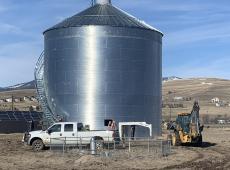A new facility is designed to study long duration burning of large woody fuels and deep organic layers with controlled ventilation. Many forests now contain large woody fuel material and continuous duff layers that can exhibit widely varying burning characteristics – from not burning at all, to smoldering slowly, to flaming vigorously. These differences have not been studied with respect to fuel arrangement or ventilation during combustion and are potentially responsible for widely varying amounts and rates of heat released and emissions produced from wildland fires. Emissions from burning these fuels may last for hours, days, or sometimes weeks, depending on the nature of burning.
Controlled ventilation means that the amount of air available for combustion is regulated, from minimal replacement air to strong winds impinging on the fuel bed. Existing facilities at the fire lab are not sufficient to control ventilation or to allow burning for very long periods – perhaps days. The facility consists of a 42’ diameter grain bin with eve-height of 37’ and total height of 55’ (see picture). Large external blowers control the desired level of airflow. Outflow will exist through the stack at the roof. The facility will regulate incoming airflow, install instruments to measure emissions of particulates, and CO, CO2, and O2 for estimating heat release rate, record continual mass loss of fuel during burning, and support assorted in-fire or adjacent measurements of radiation or temperature, for example. The controls for the burning experiments will be operated from a mobile office building located adjacent to the grain bin. Closed-circuit monitors will permit continual video recording of the burn tests.
Fuel material will be large logs, duff and organic material located on an 11 X 11 ft. burn bed mounted on load cells. The burn bed consists of an 8” deep steel sand box plumbed with propane tubes to permit complete immolation of the fuel bed by propane flames during ignition.
